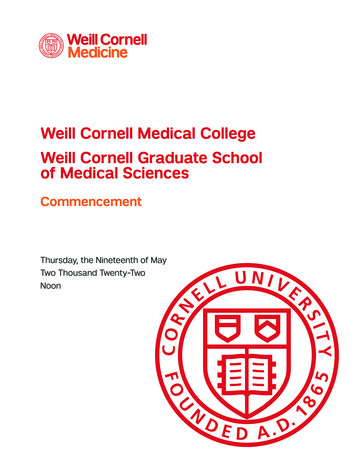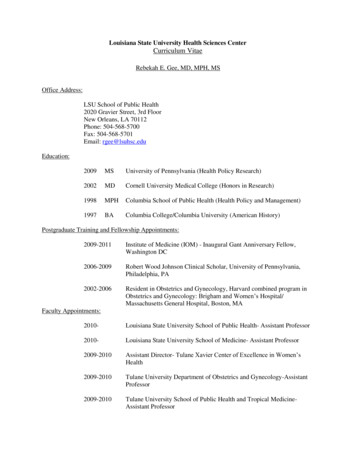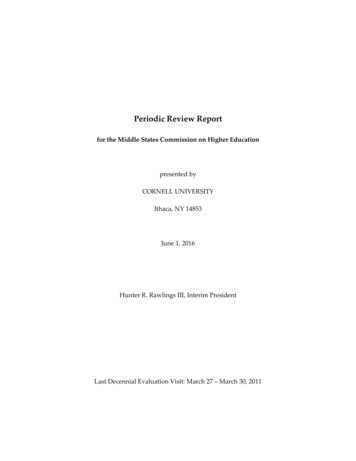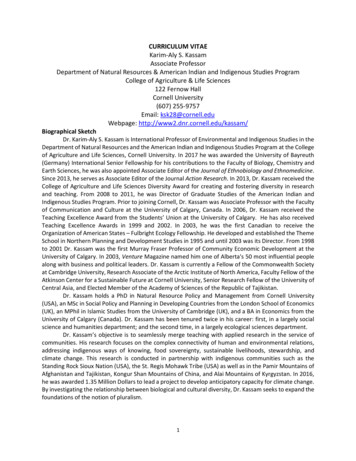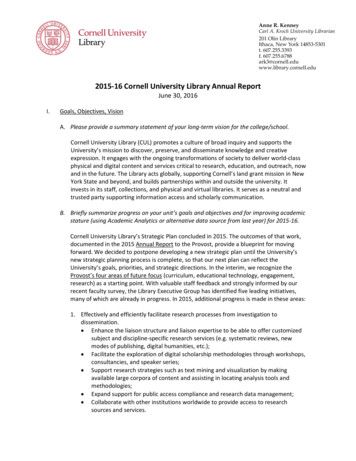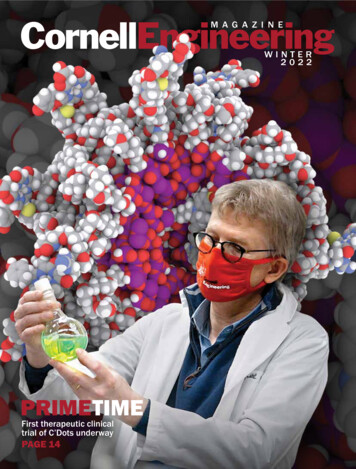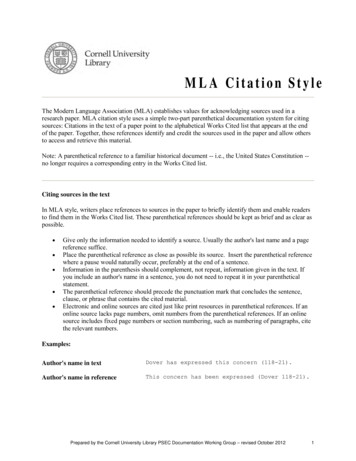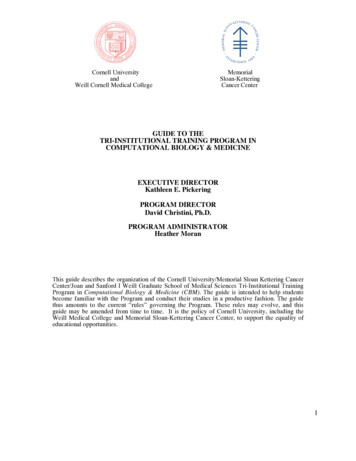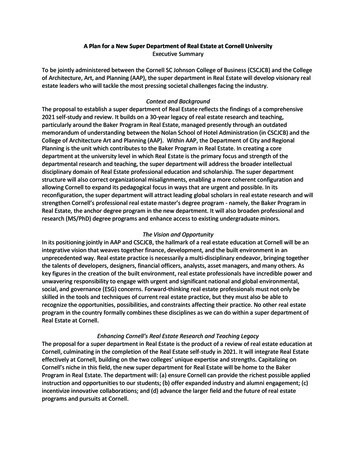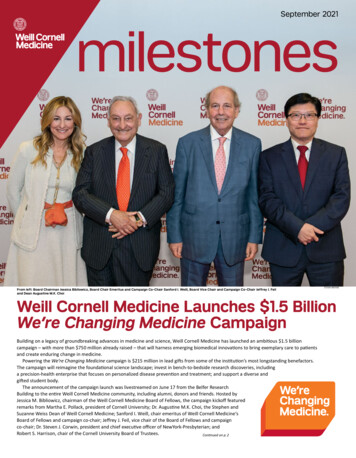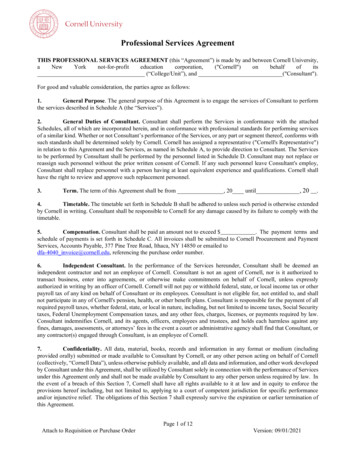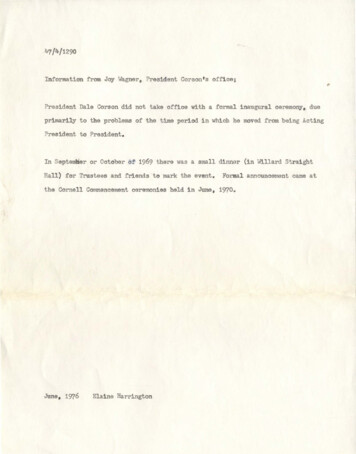
Transcription
47/4/1290Informationfrom Joy Wagner, PresidentCorson's office;PresidentDale Corson did not take office with a formal inauguralprimarilyto the problems of the time period in which he moved from being ActingPresidentto President .In Septeml'ier or Octoberof 196 thereHall) for Trustees and friendswas a small dinner (in Willard Straightto ma.rk the event.Formal announcement came atthe Cornell Commencementceremonies held in June. 1970.Elaine Harringtonceremony. due
Cornell UniversityBoard of TrusteesDinnerin honor ofDale R. Corsonon the occasion of his investitureas eighth President of Cornell UniversitySunday , June 7, 1970, 7:15 p .m.Memorial RoomWillard Straight Hall
MenuChilled Lobster, Crab, and Shrimp PlateSt. Julien 1966Fillet Mignon aux ChampignonsStuffed Baked PotatoBroccoli Spears HollandaiseChef SaladMelon Ball CoupeChampagne
PresidingRobert W. Purcell, Chairman of the Board of Trusteesof Cornell UniversityHonored GuestsClaude Bissell, President of the University of Toronto,and Mrs. BissellRobert Brode, Professor Emeritus of physics at theUniversity of California at Berkeley, and Mrs. BrodeHarris Dates, Chairman of the Tompkins County Boardof SupervisorsMrs. Edmund Ezra DayJohn Sloan Dickey, President Emeritus of DartmouthCollege, and Mrs. DickeyHoward · Dillingham, President of Ithaca College, andMrs. DillinghamLarkin H. Farinholt, Vice President and Trustee of theAlfred P. Sloan FoundationSamuel B. Gould, Chancellor of the State University ofNew York, and Mrs. GouldThe Reverend Ralph Helverson and Mrs. HelversonJames M. Hester, President of New York University,and Mrs. HesterDeane W. Malott, President Emeritus of Cornell University, and Mrs. MalottFloyd R. Newman, Presidential Councillor of CornellUniversity, and Mrs. NewmanJohn M. Olin, Trustee Emeritus of Cornell UniversityJacob Gould Schurman III and Mrs. SchurmanJulius A. Stratton, Chairman of the Board of the FordFoundation, President Emeritus of the MassachusettsInstitute of Technology, and Mrs. Stratton
Cornell UniversityCom.m.encem.ent ExercisesandInvestiture of the President- --. ·:.·- . - - . . . .11 a. m., Monday , June 8, 1970Barton Hall, Ithaca, New York
THE AUDIENCE is requested to remain seated until all the candidates fordegrees have entered the auditorium and taken their places in sections reservedfor them. At that point the audience will rise and remain standing during theprocession of the faculty and trustees. All will be seated after the invocation.PHOTOGRAPHERS are requested not to use flashbulb equipment in BartonHall during the exercises.DIPLOMAS will be distributed in the offices of the various colleges andschools immediately following the Commencement exercises, in accordancewith information previously issued by each unit.Diplomas for the Master's and Doctor's degrees 1n the Graduate School( except Master of Engineering) will be distributed in the Graduate SchoolOffice, Sage Graduate Center, after the Commencement exercises.Diplomas for Bachelor's degrees in engineering and for Master of Engineering degrees will be distributed in the offices of the several schools anddepartments, as previously announced by each unit.A special copy of the Commencement Program, containing the list ofrecipients of degrees, will be distributed with diplomas in the respectivecollege and school offices.Diplomas not called for on Commencement Day may be obtained at theOffice of the Registrar, Day Hall, beginning Tuesday, June 9.
THE ONE HUNDREDAND SECONDCOMMENCEMENTfinds today's graduates andtheir University on the brink of possibilities undreamed of even by so prescient an individual as the founder, Ezra Cornell.In 1869 when the first class was graduated, Cornell University was an innovativeforce, as it still is. One of the first secular universities, it added to the older disciplines suchpractical studies as agriculture and engineering, thus helping to meet that day's urgent economic and social needs.Then a daring experiment, the Cornell example in university education has been followed by some of the most venerable institutions of higher learning in the Western worldand by most of the new universities of developing nations everywhere .The University today remains, as it was under the first President, Andrew DicksonWhite, and the Founder, an interesting combination of European scholarly attitudes andAmerican educational ideas. Traditional studies-the humanities-stilloccupy a centralplace at Cornell, and during the period since the first Commencement the University hasestablished modern areas of study and research that represent virtually the full range ofman's intellectual inquiry and professional service.At the University's first Commencement, each of the eight graduating studentsmounted the stage to receive a vellum diploma rolled and tied with a carnelian-colored silkribbon. President White had composed the wording of the diplomas. Ezra Cornell himself had mailed the invitations.Those present today may be interested to note that in 1869, according to the IthacaJournal, among the huge crowd watching the Commencement procession were "the fairestladies ever assembled for a college Commencement."The ceremonies ended with the awarding of prizes and an address by PresidentWhite. At the President's reception later that evening, strawberries, ice cream, cake, andlemonade were served.Today, nearly 2,500 men and women will receive degrees. They face unprecedentedchallenges and opportunities in a world where their scholarship, skills, and thoughtfulhabits of mind are needed as never before.3
Notes on CommencementTHE PROCESSIONThe academic procession (in good weather) forms on the Arts College Quadrangleand marches in the following order: (1) candidates for degrees, those for advanceddegrees leading; (2) members of the faculty; and (3) trustees, vice presidents, deans, theprovost, and the President. The procession is led by the University marshal.When the procession enters the auditorium, candidates for degrees are directed totheir places in front of the platform. The faculty take places on the two wing platforms,and finally the trustees, the University officers, the deans, and the President mount the cen ter platform for the ceremonies.The University baton and the University mace are carried at such public events as theCommencement procession and exercises. The baton is carried by the University marshal ashe forms and directs the academic procession. The mace symbolizes the authority of theUniversity as exercised by its principal officers, especially its President. Both the baton andthe mace were designed by Sir Eric Clements of the Goldsmiths' Guild of London. Thebaton is constructed of a rosewood shaft with a wrought-silver triangular knob, bearing arendering of the University arms, and surrounded by a frieze of engraved ivy leaves. Themace consists of a tapered silver shaft surmounted by a golden terrestrial globe. The silverribs surrounding the globe symbolize the universality of Cornell's interests and the world wide associations of its faculty, students, and alumni.Above the platform hang the banners of some of the ancient universities from whichCornell derives its tradition of learning and teaching. From left to right: Oxford, Cam bridge, Edinburgh, Dublin, Heidelberg, and Paris.ACADEMIC COSTUMEAcademic costume in the United States usually conforms to an intercollegiate codeestablished in 1895. The gown is commonly black, differing in design to accord with thelevel of the wearer's degree. The doctoral gown is paneled in velvet, with three matchingvelvet bars on the sleeves. The panels and bars may be of black or of the color indicatingthe general field of the degree conferred. For example, the velvet may be blue for the doc torate of philosophy, purple for the doctorate of laws, and gray for the doctorate of veteri nary medicine. Black velvet is equally correct for all fields. Trustees wear doctoral gowns.The University marshal and the mace-bearer wear marshals' ceremonial gowns of solidcarnelian. Recipients of the Cornell doctorate are authorized to wear gowns of carnelian ifthey prefer them to black.4
The tassel on the academic cap or hat may be either black or the color indicating thefield of the degree. Colors for Cornell degrees are: arts and sciences, white; agriculture,maize; business and public administration, olive; education, light blue; engineering,orange; fine arts and architecture, brown; human ecology, maroon; hotel administration,dark red; industrial and labor relations, orange-yellow; law, purple; medicine, green; veterinary medicine, gray . Doctors may wear gold tassels on their caps or hats. Cornell in someinstances has modified the established color code in order to recognize different types ofthe Bachelor of Science degree, which is granted in several divisions.The hood is the most distinctive feature of the academic costume. It still faintly suggests the medieval cowl from which it derives. Its velvet border, most visible from thefront, indicates by its color the general field of the degree-just as the tassel may do. Its silklining, seen at the back, is turned partly inside out, the better to display the color or colors ofthe institution that awarded the degree. The Cornell hood may be identified by its liningof carnelian, with two white chevrons.Among other institutional colors frequently seen at Cornell Commencements are:Brown University, brown; California, gold, blue chevron; Chicago, maroon; Columbia,light blue, white chevron; Harvard, crimson; Illinois, dark blue, two orange chevrons; Indiana, crimson, white chevron; Iowa, old gold; Johns Hopkins, dark blue, gold chevron;Michigan, maize, azure-blue chevron; Massachusetts Institute of Technology, bright red,silver gray chevron; Pennsylvania, cardinal, blue chevron; Princeton, orange, black chevron; Stanford, cardinal; Wisconsin, bright red; Yale, dark blue.HONORARY DEGREESCornell does not award honorary degrees. Two exceptions were made in the earlydays when degrees were conferred simultaneously on Andrew D. White, the first President, and on David Starr Jordan, a graduate of Cornell's first four -year class who becamethe first president of Stanford University.THE CORNELL PH.D.Cornell first conferred the degree of Doctor of Philosophy in 1872, only four yearsafter the University opened. The University was one of the first three institutions in America to grant this most advanced of all degrees and has conferred it on more than 9,000men and women.Candidates for the Ph.D. degree come to Cornell from many lands and engage them. selves in intensive studies in a great variety of subjects. Their studies represent the breadthof the fields into which they have ventured and the depth to which their investigations havetaken them. This range and variety clearly reveal that the horizons of man's knowledge ofhimself, the world in which he lives, and the larger universe are being pushed steadily forward, year by year, by men and women of scholarly purpose and attainment.5,.
Investiture of the PresidentPresidents of the University traditionally have been inducted into office and presentedto the academic community with appropriate exercises. Such observances tended to behighly elaborate in the spacious early days of Cornell , but they have steadily moved towardgreater simplicity in modem times. Today's investiture of the eighth President is the first tobe performed as part of a University commencement. It marks the formal and ceremonialrecognition of the presidency of Dale R. Corson.All the Presidents since the foundation of Cornell have been men of high qualifications and public eminence. None though, whatever their other distinctions, have broughtto the position so long an association and so varied an experience with the University asdoes Dale Corson. Professor, departmental chairman, dean, and provost-teacher, researchscholar, and administrator-the new President in today's brief ceremony receives from thetrustees the University mace, symbolizing the authority and responsibility of his high office.DISTINGUISHEDCLAUDEBISSELLPresident, University of TorontoROBERT BRODEProfessor Emeritus of physics, University ofCaliforniaH.Aruus DATESChairman, Tompkins County Board ofSupervisorsRepresenting Tompkins CountyGUESTSJAMESM. HESTERPresident, New York UniversityRepresenting the Association of Colleges andUniversities of the State of New YorkDEANE W . MALOTIPresident Emeritus, Cornell UniversityDoNALD McMASTERPresidential Councillor, Cornell UniversityMRs. EDMUNDEZRADAYWife of Edmund Ezra Day, former PresidentFLOYDR. NEWMANPresidential Councillor, Cornell Universityof Cornell UniversityJOHN SLOANDICKEYPresident Emeritus, Dartmouth CollegeRepresenting the Ivy League colleges anduniversitiesEWALDB. NYQUISTCommissioner of Education, State EducationDepartmentRepresenting the Regents of the State of NewYork and the State Education DepartmentHOWARDDILLINGHAMPresident, Ithaca CollegeJOHN M . OLINTrustee Emeritus, Cornell UniversityLARKINH. FARINHOLTVice President and Trustee, the Alfred P.Sloan FoundationJACOB GouLD SCHURMANIIIGrandson of Jacob Gould Schurman, formerPresident of Cornell UniversitySAMUELB. GouLDChancellor, State University of New YorkTHE REVERENDRALPHHELVERSONFormer Unitarian Chaplain, Cornell University6JULIUS A. STRATTONChairman of the Board, the Ford FoundationPresident Emeritus, Massachusetts Institute ofTechnology
ProgramPRELUDEThe Cornell University Wind Ensemble, Professor MARICEW. STITH,Conductor,.THE ACADEMIC PROCESSIONProfessor BLANCHARDL. RIDEOUT, University MarshalProfessor Emeritus MORRISG. BISHOP,MacebearerPRESENTATION OF THE ACADEMIC ASSEMBLYProfessor RIDEOUTAMERICA(to be sung by the assembly)My country, 'tis of thee,Our fathers' God, to Thee,Author of liberty,To Thee we sing;Long may our land be brightWith freedom's holy light;Protect us by Thy might,Great God our king .Sweet land of liberty,Of thee I sing;Land where my fathers died,Land of the pilgrims' pride,From ev'ry mountain sideLet freedom ring.INVOCATIONThe Reverend RICHARDS. GILBERTUnitarian Chaplain, Cornell University"Graduation : The Anguish and the Challenge"The Reverend DAVIDW. CONNORCatholic Chaplain, Cornell UniversityINTRODUCTION OF THE GUEST SPEAKERROBERTW. PURCELLChairman of the Board of Trustees, Cornell University"The President and His University, 1970"Juuus A. STRATTONChairman of the Board, the Ford FoundationPresident Emeritus, Massachusetts Institute of Technology7
INVESTITURE OF DALE R. CORSON AS PRESIDENT OF THE UNIVERSITYMr. PURCELLANTHEMSalute to the PresidentCharles GounodDomine salvum fac praesidem nostrum, et exaudi nos in die qui invocaverimus te.The Cornell University Glee Oub, Professor THOMASA. SoKOL, DirectorThe Cornell University Wind EnsembleADDRESSPresident CORSONANTHEMHenry Leland ClarkeNo Man Is an IslandText by John DonneThe Glee Oub and Wind EnsembleCONFERRING OF DEGREESBy PRESIDENTCORSONBachelors of Arts: Presented by the Dean of the College of Arts and Sciences, Professor ALFREDE. KAHN.Bachelors of Science (Agriculture) : Presented by the Dean of the New York State College ofAgriculture at Cornell University, Professor CHARLESE. PALM.Bachelors of Science (Human Ecology) : Presented by the Dean of the New York State Collegeof Human Ecology at Cornell University, Professor DAVIDC. KNAPP.Bachelors of Science (Hotel Administration):Administration, Professor ROBERTA. BECK.Presented by the Dean of the School of HotelBachelors of Science (Industrial and Labor Relations) : Presented by the Dean of the New YorkState School of Industrial and Labor Relations at Cornell University, Professor DAVIDG. MOORE.Bachelors of Architecture: Presented by the Dean of the College of Architecture, Art, and Planning,Professor BURNHAMKELLY.Bachelors of Fine Arts: Presented by Dean KELLY.Bachelors of Science (Engineering) and Masters of Engineering (Aerospace) : Presented by the Deanof the College of Engineering, Professor ANDREWSCHULTZ,JR.Doctors of Veterinary Medicine: Presented by the Dean of the New York State Veterinary Collegeat Cornell University, Professor GEORGEC. PoPPENSIEK.Masters of Business Administration and Masters of Public Administration: Presented by the Dean ofthe Graduate School of Business and Public Administration, Professor H. JusnN DAVIDSON.8
Masters of Arts, Masters of Science, and Other Masters' Degrees : Presented by the Dean of theGraduate School, Professor W. DONALDCOOKE.Doctors of Philosophy and Other Doctoral Degrees: Presented by Dean COOKE.ALMA MATER( to be jung by the assembly)Far above Cayuga's waters,With its waves of blue,Stands our noble Alma Mater,Glorious to view.Far above the busy hummingOf the bustling town,Reared against the arch of heaven,Looks she proudly down.Refrain:Lift the chorus, speed it onward,Loud her praises tell;Hail to thee, our Alma Mater !Hail, all hail, Cornell !EVENING SONGThe Glee dubBENEDICTIONThe Reverend MR. GILBERTRECESSIONAL[The members of the grad11a1ingclass and audience will remain standing in place during the AlmaMaler, the Evening Song, and the Benediction, and 11ntilthe President, the trustees, and the facultyhave left the hall. They will then disband.]9
THE ACADEMIC PROCESSIONFaculty MarshalsUniversity MarshalL. RIDEOUTW. DAVID CURTISSBLANCHARDL. EVERETTA. K!ERSCHHERBERTGEORGEMacebearerPAUL ]. LEURGANSMORRJS G. BISHOPSIMPSON LINKEJOHN W.MACDONALDMarshal's AidesFRANK B. MILLERRODNEY E. DENNISJOSEPH L. ROSSONFREDERICK R. HODGSONFRANCIS B. SAULWALLACECLASSMARSHALSMARK E. WIENERJAMES E. BAADENFIRSTANDGROUPMARSHALSB. Arch.A.B.JOHNJAMES ANDREWROGER STANLEYJONATHANB.S.DoNC. SMITHJULIANB. ROGERSI.CARRJOEL LORD BOSTWICKKATZ(Agriculture)B.F.A.PAUL DEPREZCONSTANCEPATRICIA MARY STANLEYKAMENSKIM DUBINB.S. (Engineering)RICHARD B. MARCHASED.V.M.ROBERT EARLE GROVELAWRENCEB.S.(Hotel Administration)DAVID EUGENEWILLIAMDAVIDA.ALANKAHNSTRINGFELLOWLEMONROY SEABURGM.B.A., M.P.A.(Human Ecology)B.S.PATRICIA ANNANNEB.S.CLEMENTKANELOUISE CRANDALL(Industrial and Labor Relations)DoUGLASHOWARD GINSBURGMaster's DegreesEDWARD JAMES MCGLYNNSIMEON GOLDCOMMITTEECHARLOTTEONJOHN10ROGER CosTERSLAWRENCE ARTHUR TERKELCOMMENCEMENTF. McMANus,ARRANGEMENTSChairmanH. GoLD
The University baton and the University mace are carried at such public events as the Commencement procession and exercises. The baton is carried by the University marshal as he forms and directs the academic procession. The mace symbolizes the authority of the University as exercised by its principal officers, especially its President.
